indigenous
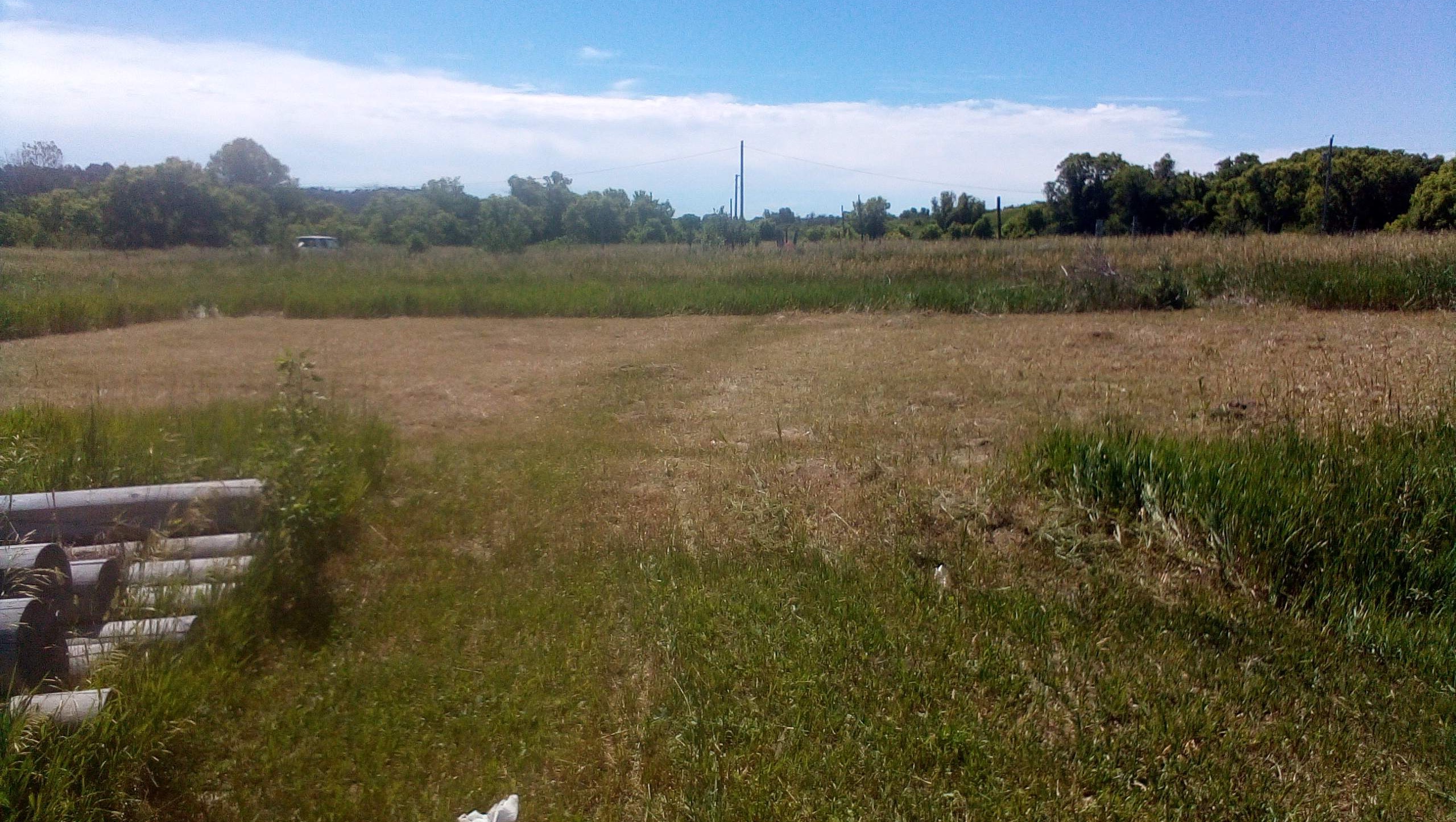 www.gofundme.com
www.gofundme.com
Secondarily there is also another urgent ask for a trailer for our permaculture specialists https://ko-fi.com/emsenn 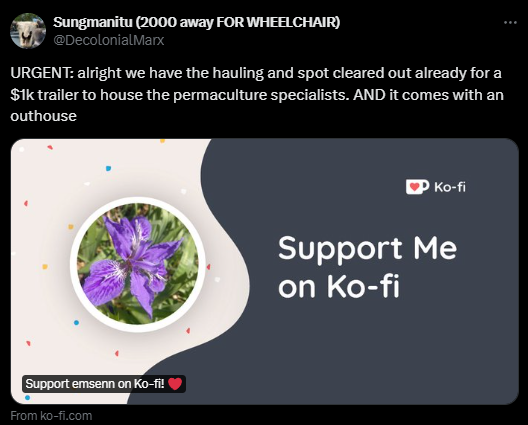

Here is a bit of an update post for CLN and the many things we have underway, our goals, and plans to accomplish them though it is in slide form, just trying to condense larger documents that are being finalized  Our main goal is to offer an actual Marxist-Leninist position on landback, that is easier to articulate than the current offerings by many groups that all boil to Indigenous self determination and ending of global colonial exploitation 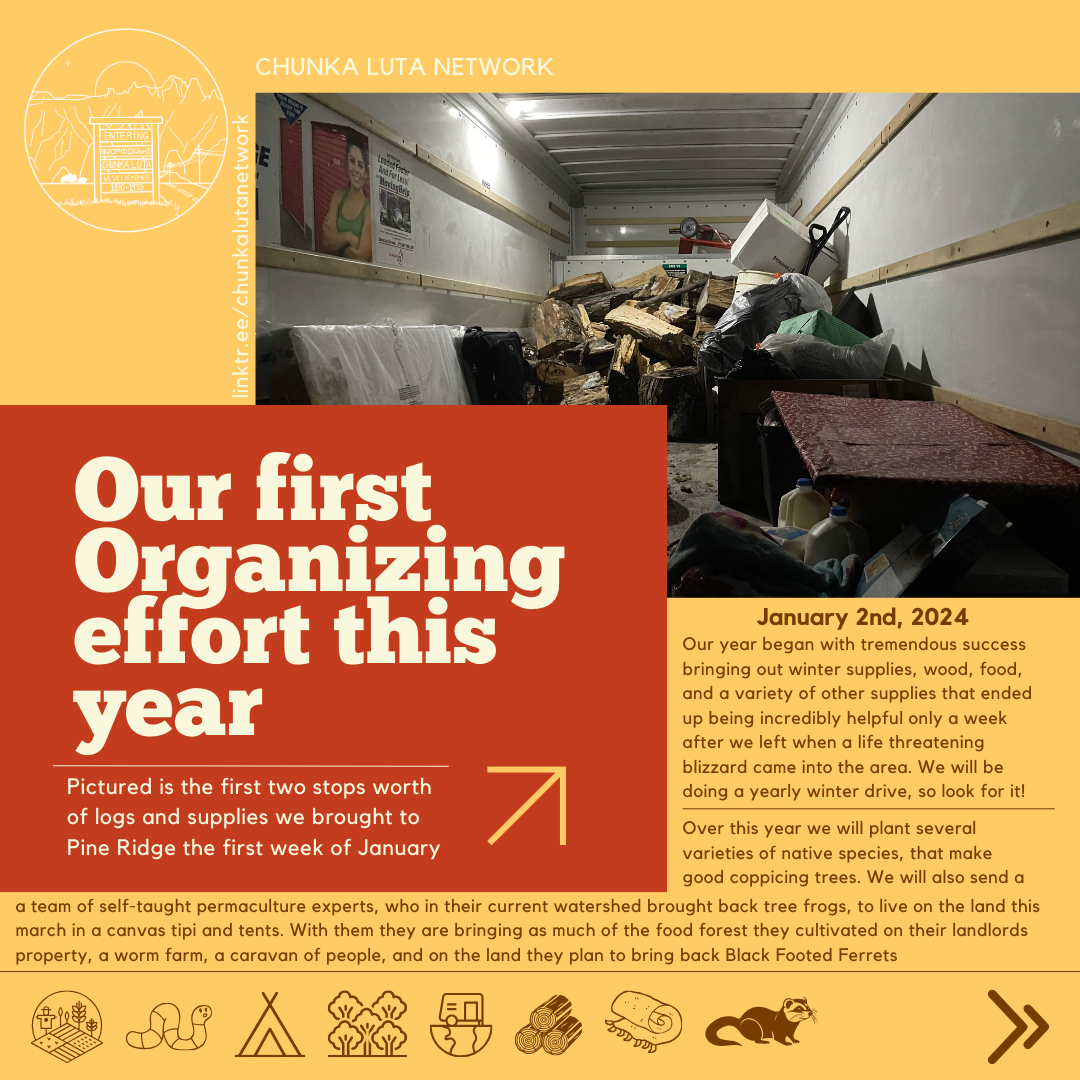 We are a organization based in demcent, and scientific socialism. There are many like minded groups and individuals working towards the collective liberation of the land, and life from the contradictions of colonialism and Imperialism. 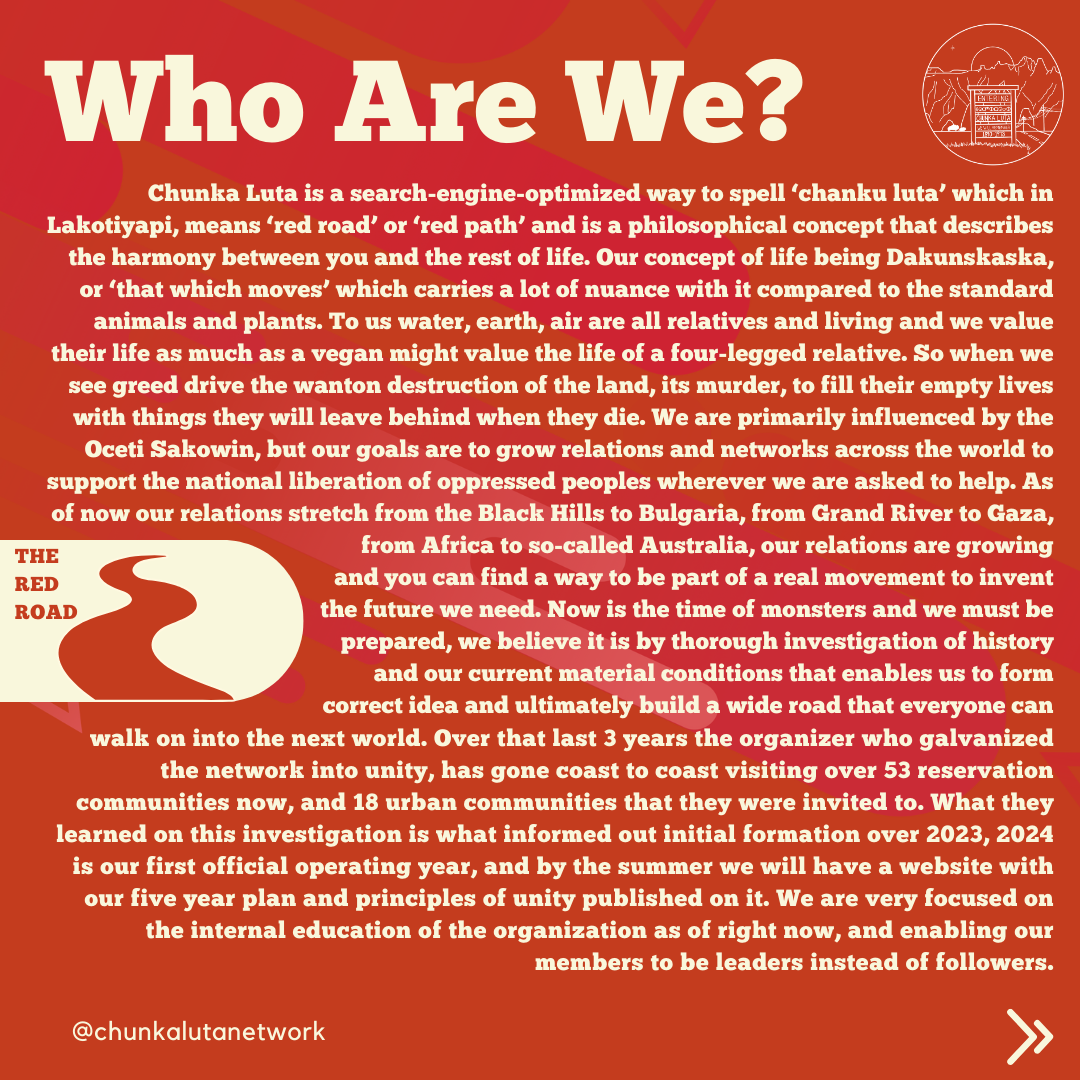 Our goal is to go beyond cheerleading, and instead enable people to lead. This was my largest criticism of The Red Nations "The Red Deal" and you can hear more of my in depth thoughts starting Season 8 on the Marx Madness podcast. I offer 40 hours of reading you the book word for word and offering my criticism as openly as I could.  The specific house at risk of seizure is my dad's who is a Union member, and my brother who has a different dad but live with my dad also live there. They have 3 kids in the house and he's a native with a record in a bordertown so the financial situation has been hard after some medical issues occurred, some legal issues, and then some neighbor issues on top of the city raising water rates and their bill being $400 this month so they could really use this help and can even pay people back if you want after they get their tax return which has been delayed for one reason or another due to paper work taking a while to get to them. 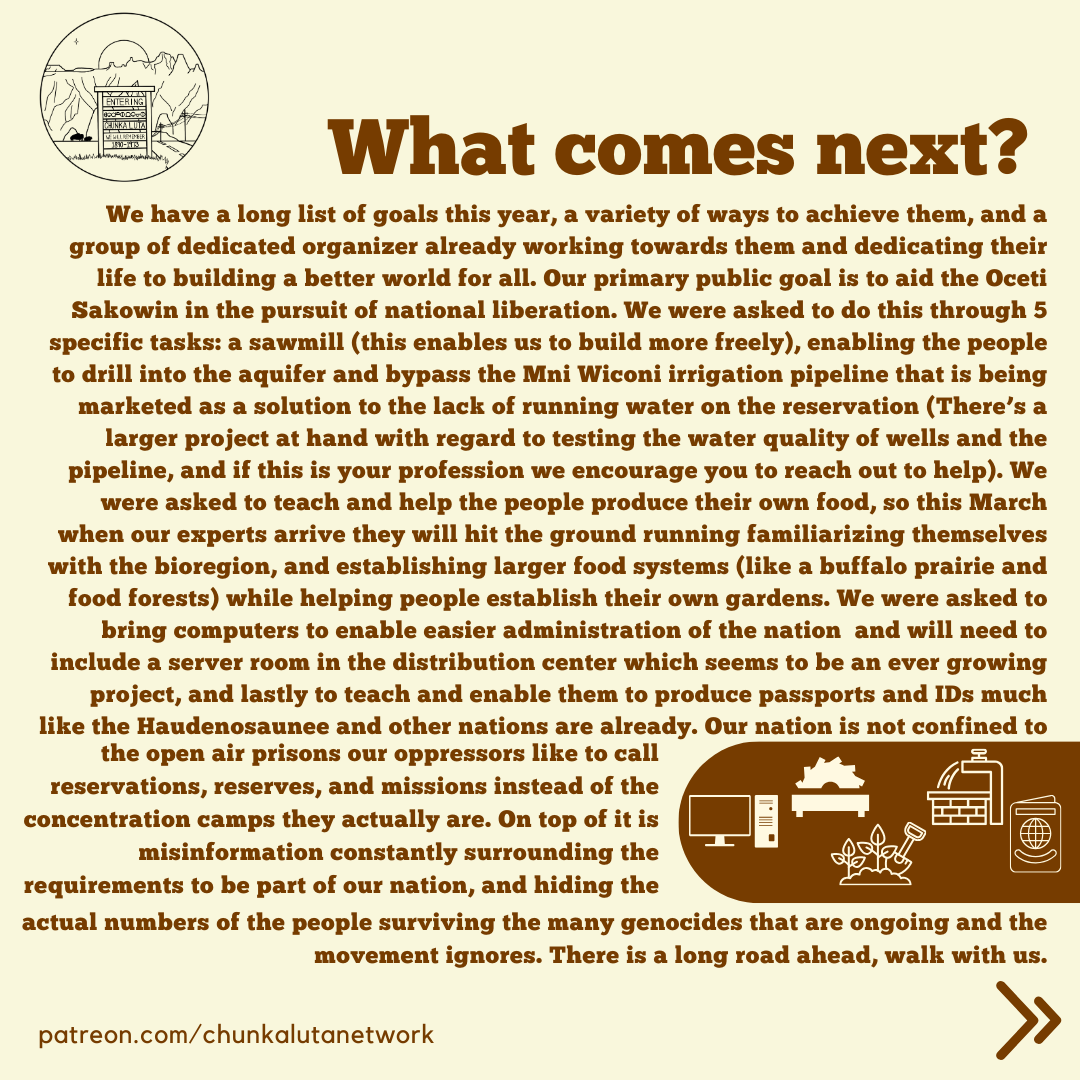 Our biggest goal is self determination through dual power systems during a war of position. Through this preparation we demonstrate an ability to build, plan, and lead. This we think is an important ability for any cadre, and we do this through building up cadres in different regions across the world.  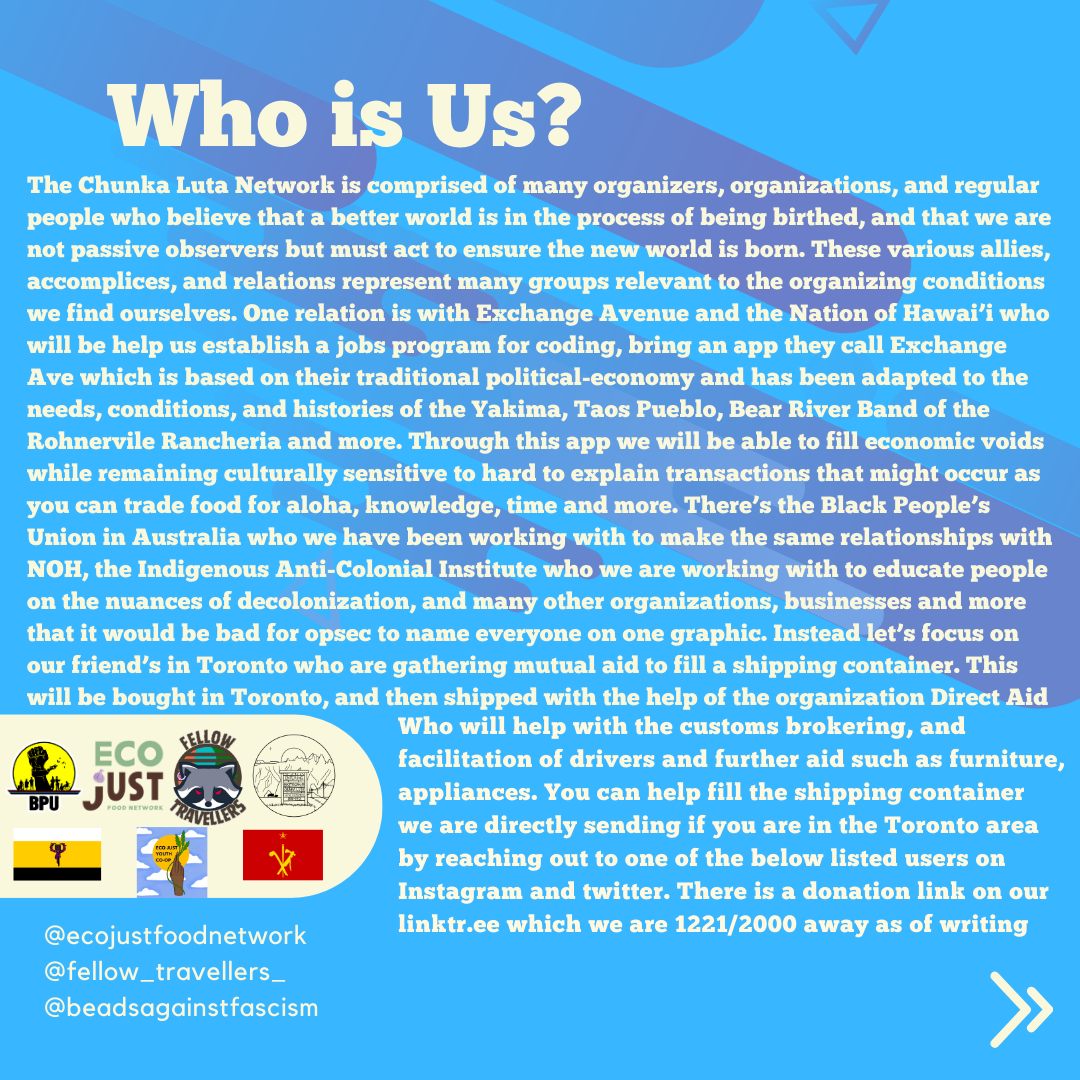 One of these groups is in Toronto and is working to send the shipping container we are raising money for to pay back the organizers who fronted the last portions to assure we got the container in time for the deadline.  We are of course most excited about the future so I encourage people to keep their eye out for the website where we will be uploading public viewable financial information, there we will also replace the patreon and liberapay but for now you can find links to those https://linktr.ee/chunkalutanetwork as well as various GFM links to efforts mentioned in the updates  We are doing great things and I think everyone should check out our friends at the Nation of Hawai'i, Black Peoples Union in Australia, and more

Here is a dossier we have been developing for the last year, that's gone through a review by the communities we serve, as well as our organizers, and now it is time for our public review: That is why I am posting this here         Along with videos in development, a further public five year plan, and several theoretical pieces of our unique contribution to the contemporary theoretical landscape, we have joined with the budding Indigenous Anti-Colonial Institute that you can find the first episode on youtube and spotify idk about anything else yet. Already this year we brought a 20' Uhaul full of wood, winter gear, hygiene materials, gardening materials, and whatever else we could fit like a child's bed. We also raised the money to purchase a new home on the land, are in the process of sending 40 lbs of socks to the Rez, raised 500/2500 of the storage container costs we need by the end of the month, are finalizing our Principles of Unity, facilitating 4 nation to nation treaties, are halfway to our goal of 2k a month to support our organizers survival with 500 stipends, and have raised several thousand dollars in the last day to keep folks alive during this deadly weather  I am attempting to bypass the character limit via the photos so forgive me. However we are on a great trajectory and the momentum is undeniable. On https://linktr.ee/chunkalutanetwork you can see several fundraising efforts we are doing and see our liberpay and patreon options to become monthly sustainers of our efforts, our website will be launching later this year, and really get involved. Help out. Theres so many ways and I think we are proving ourselves very capable at organizing great things, and you will see us move mountains this year. So follow our various social medias, and Im seriously going to try to engage here this year. I just hate social media in general and this doesnt give me a bright notification on my phone. We also highly encourage sharing and in our library (once I update the materials available) stuff like this will be readily accessible for your posting pleasure

https://youtu.be/4j48owNmquc?feature=shared here's a great video featuring more of the Swallow family, new media from the winter drive coming soon check out our linktr.ee/chunkalutanetwork for ways to support our work and organizing efforts. > yewtu.be
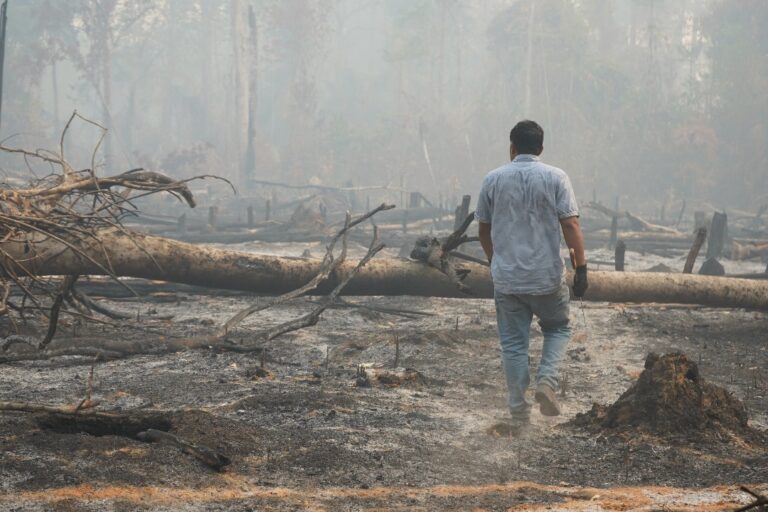 news.mongabay.com
news.mongabay.com
- Almost 20% of the Kayapó Indigenous Territory has burned in this year’s Amazon drought, the worst ever recorded in Brazil. - The land has for years been subjected to illegal mining, cattle ranching and burning of forests, degrading both the soil and rivers and significantly disrupting the way of life for the Mebêngôkre-Kayapó people. - The Indigenous inhabitants now confront a growing crisis as wildfires and drought threaten their lands, particularly along the Riozinho River. - According to ecologist Rodolfo Salm, who has worked with the Kayapó since 1996, fire has now surpassed illegal logging as the greatest danger to the region. >SÃO FÉLIX DO XINGU, Brazil — In the village of Tepdjàti, nestled deep within the Kayapó Indigenous Territory in the Brazilian Amazon, the air is thick with smoke and the landscape is parched. The village’s only water source is an artesian well with a solar-power pump. But the thick smoke from nearby wildfires has blocked out the sunlight, leaving the device without any power. >Even water from the nearby river, once a lifeline for the village, has become polluted and undrinkable. “It’s not suitable for bathing, drinking, or preparing our food,” Ngory Maradona Kayapó, a local leader, tells Mongabay. The situation is dire, with crops like bananas, yams and manioc, all vital to the Indigenous villagers’ subsistence, reduced to ash by a recent fire. >This village is just one of many across the Kayapó Indigenous Territory, in the state of Pará, that’s grappling with the devastating effects of Brazil’s worst drought on record. The Riozinho River, which once sustained them, is now dry, forcing them to rely on contaminated streams for water. The drought, coupled with rampant wildfires, has wreaked havoc on the Kayapó way of life. With low river levels, boats, the primary form of transportation, cannot be used for delivering food or medicine or for transporting patients to hospitals. “The medicine that comes from the health service is very little. Many children are suffering from vomiting, diarrhea and fever,” Ngory says. [full article](https://news.mongabay.com/2024/10/extreme-drought-wrecks-rivers-and-daily-life-in-amazons-most-burnt-indigenous-land/)
 mondoweiss.net
mondoweiss.net
>The Israeli offensive against northern Gaza continues for the twelfth day in a row, imposing a brutal siege on an area that houses at least 200,000 Palestinians. The offensive, which began in early October, is targeting the town and refugee camp of Jabalia, in addition to Beit Lahia and Beit Hanoun, and has featured a massive air and ground assault to destroy the infrastructure that remains in those areas. >The Israeli army ordered residents of northern Gaza to leave, indicating only one route through Salah al-Din Street that extends from Gaza’s north to the south. Most crucially, this prevents residents from fleeing to Gaza City and staying north of Wadi Gaza. Jabalia in particular has received the brunt of the Israeli attack. Eyewitness testimony shared with Mondoweiss indicates that the Israeli army’s strangulation of Jabalia has served as a siege within the larger siege of northern Gaza. >During the recent onslaught, the camp has been pounded with heavy artillery and airstrikes while Palestinian residents have also been targeted with quadcopter drones. On Thursday, October 17, an Israeli airstrike targeted the Abu Hussein boys school in Western Jabalia, where thousands of Palestinians took shelter. The strike, conducted with two air missiles, killed at least 28 Palestinians, including children, and wounded more than 50. [Full article](https://mondoweiss.net/2024/10/bombings-killer-drones-and-starvation-eyewitnesses-describe-israels-extermination-campaign-in-northern-gaza/)

[linky to tweet](https://xcancel.com/ScooterCasterNY/status/1846308635577929730) >Muwekma Ohlone Tribe were arrested on their second day of encampment outside capitol building, after their "trail of truth" journey from San Jose, California to DC. Group camped out on the lawn outside the capitol building to protest the governments refusal to recognize the Muwekma tribe federally. >The Muwekma Ohlone Tribe is an unrecognized organization for people who identify as descendants of the Ohlone, an historic Indigenous people of California.
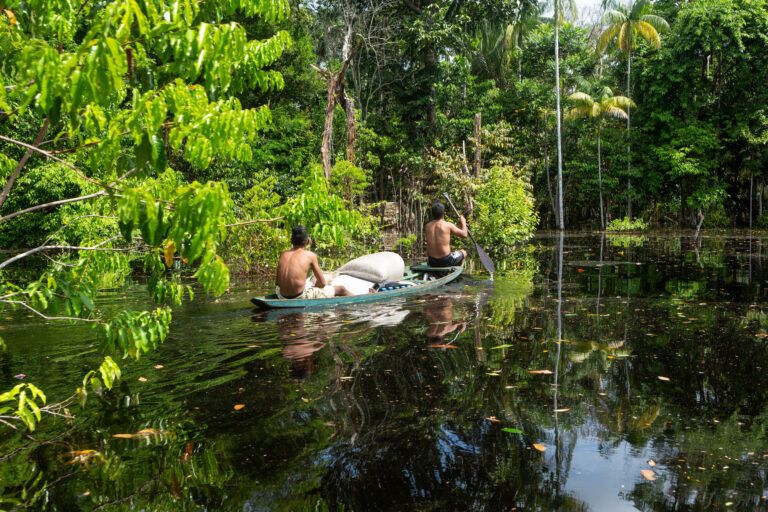 news.mongabay.com
news.mongabay.com
- Before the arrival of European colonizers, rural societies in the Amazon Basin domesticated plants and developed agricultural practices and infrastructure which provided supplies of food and fiber and improved crop yields. - As missionaries and the expansion of trade brought pathogens into communities which lacked immunity, the number of Indigenous people across the Amazon dropped drastically in the fifteenth and sixteenth centuries, from an estimated 4 to 15 million people to about 400,000. - In Brazil, a population census in the early 1990s showed an increase of Indigenous population, indicating higher birth rates and increased Indigenous self-identification. Boosting the latter across the Amazon Basin requires policies that prioritize the formalization of land rights of communities with specific ethnic heritage. >Prior to the arrival of Europeans, the Amazonian lowlands were home to several hundred ethnic groups living in tens of thousands of villages with a population estimated at between four and fifteen million inhabitants. Over millennia, these societies transformed landscapes along the main stem of the Amazon River and its major southern tributaries by developing agricultural practices that created dark earth soils, a technology that improved the physical and chemical properties of tropical soils, increased their productivity and ensured their sustainable use over centuries. >Tragically, all of these societies collapsed in the fifteenth and sixteenth and centuries, when epidemics caused by pathogens introduced during the Colombian Exchange burned through their communities. Although archaeology has yet to discover all the gruesome details, these societies were particularly susceptible to pandemics because of their relatively high population density and a trade network that promoted cultural interactions. The population is believed to have fallen to fewer than 400,000 individuals in a cataclysmic demographic collapse. >The rubber boom of the late nineteenth century led to another round of decimation, as Indigenous communities were enslaved, displaced or massacred. Most survived as ethnic entities by fleeing deeper into the forest, occupying forest landscapes along tertiary tributaries or remote valleys in the Andean foothills and Guiana highlands. Anthropologists estimate that Amazonian Brazil had a population of only about 100,000 Indigenous people in the mid-1970s. [Full article](https://news.mongabay.com/2024/10/indigenous-communities-in-the-amazon-jungle-fight-for-full-recognition/)
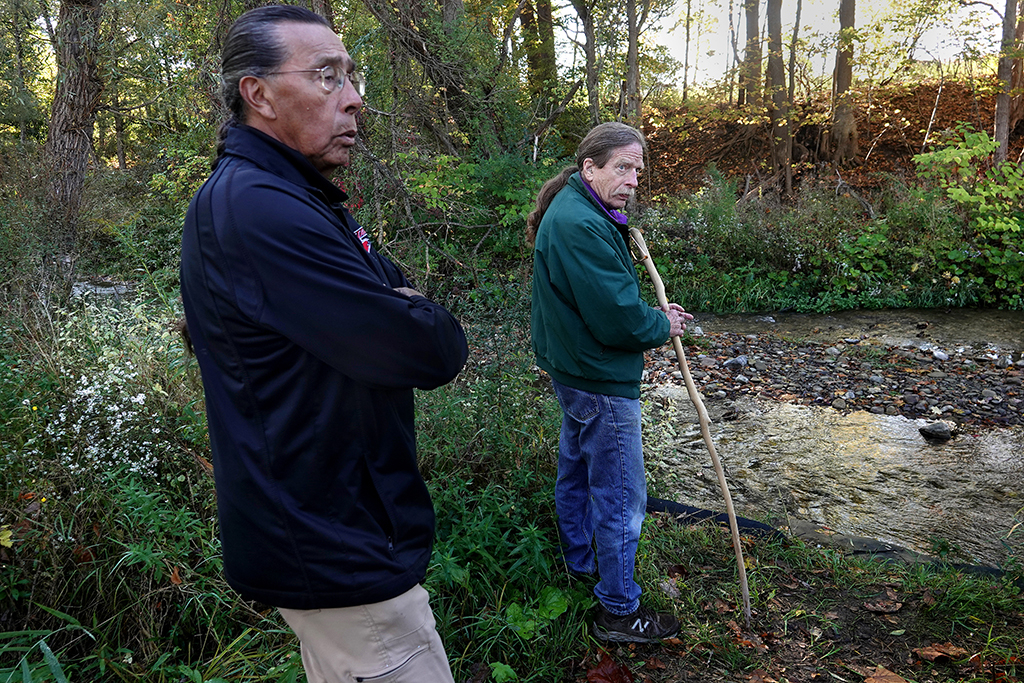 centralcurrent.org
centralcurrent.org
>After the completion of a land transfer from Honeywell International on Sept. 30, the Onondaga Nation reclaimed over 1,000 acres of their historic land, which include the pristine headwaters of Onondaga Creek and a bounty of native wildlife and natural medicines. >Hill, the Tadodaho of the Onondaga Nation, remembers swimming in the creek water as a child. Nowadays, Hill said, children don’t swim in the creek, whose downstream waters are brown and murky. Those downstream waters run full with silt and other deposits from mud boils, caused by salt mining. >“You have Onondaga Creek, you have Onondaga Lake. Can’t use these places,” Hill said. “I’m an Onondaga. What’s that tell you?” >Here, however, in the land the Onondagas reacquired, dozens of headwaters remain clean, clear and cold – safe for consumption, and ideal for native brook trout to thrive. >The 1,000 acres — two separate 758-acre and 256-acre parcels — are a mere fraction of the 2.5 million acres guaranteed to the Onondagas in treaties with the US government. This title transfer, though, represents a critical milestone in the Nation’s ongoing battle to regain its ancestral lands. >The transfer of land followed a 2022 resolution from the The U.S. Fish and Wildlife Service and New York State Department of Environmental Conservation that came as part of a broader plan to restore Onondaga Lake. The agencies directed Honeywell International, the corporation that owned the land, to cede the title of the parcels to the Onondaga Nation. >For more than half a century, Honeywell conducted solution salt mining, a process in which water is pumped underground to dissolve salt and push the brine to the surface. Decades of mining depleted the soil, leaving massive vacuums where the salt once was. [Full article](https://centralcurrent.org/the-onondaga-nation-reclaimed-1000-acres-of-its-land-now-it-seeks-restoration/)
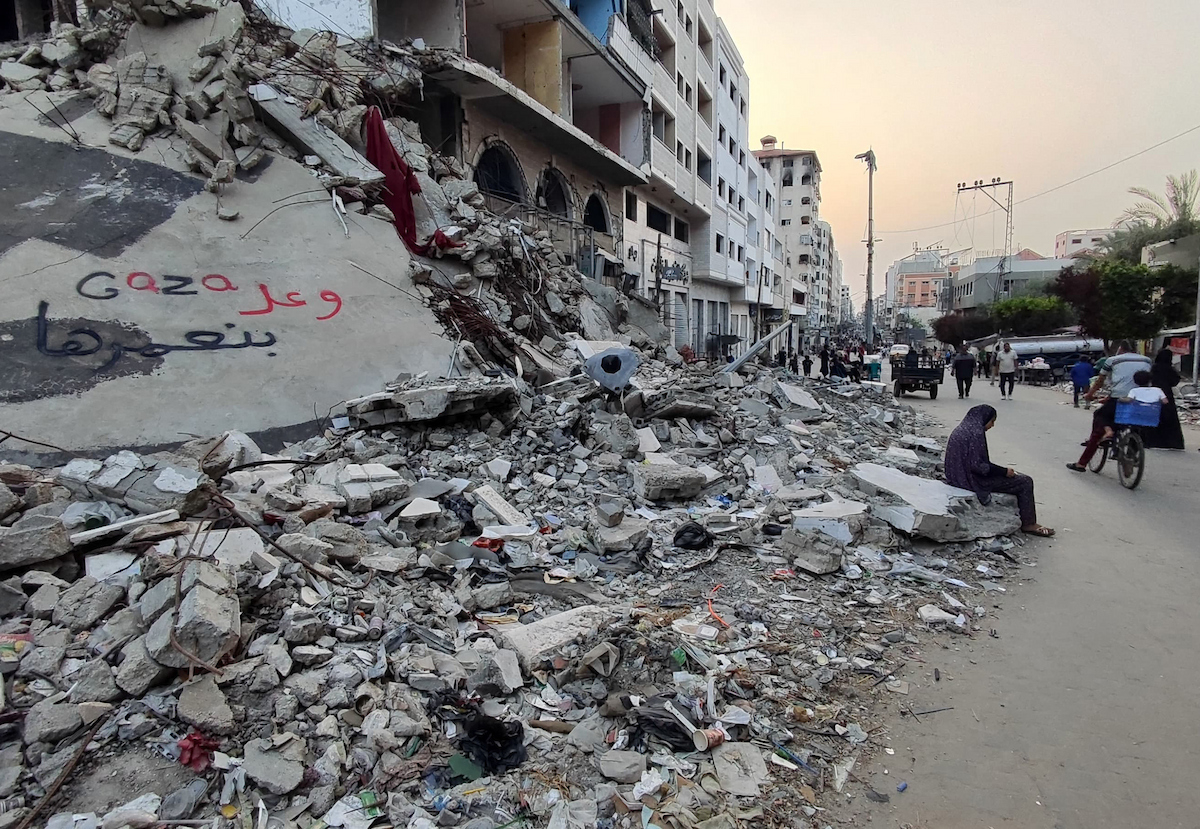 mondoweiss.net
mondoweiss.net
>A year ago, Palestinians began to experience new levels of their ongoing catastrophe, the Nakba, which started 76 years ago. In response to the attack that killed roughly 1,200 Israelis and caused a major embarrassment to the Israeli army and intelligence, Israel unleashed an extermination campaign on Gaza, leveling entire residential blocks, destroying education and health institutions, eliminating the basic infrastructure needed to sustain a society, and burying entire families under the rubble. >In the West Bank, Israeli settlers set out to forcibly expel Palestinian rural communities and steal the lands of Palestinian towns and villages. The Israeli army ramped up its spree of raids on refugee camps, destroying their infrastructure, and systematically forcing inhabitants to live in a situation similar to the one lived in Gaza. >I have lived in Palestine almost all my life. The Nakba has always been part of my consciousness. Its continuity has been my reality. However, there are particular dimensions to the experience of living the Nakba that I had never known, except in the memories of those who lived in its early years. My father, who grew up in the 1950s and 1960s, always struggles to contain his tears when he describes the refugee families, expelled from West Jerusalem, Lydd, Ramleh, and their surrounding villages, and how they were still sleeping in stables and caves in our hometown in the late 1950s because all the houses were taken. >He would describe how they had lost all their possessions and were forced into underpaid labor in the fields to sustain themselves, how some of their children had bare floors for beds, and how they had gradually started to become part of the town’s social fabric. Some of them, with peasant origins, took their sick children to the church in our Christian town and, despite being Muslims, had them baptized out of simple religiosity, imploring the Virgin, the saints, and the prophet Muhammad to heal them because they couldn’t afford medical care. [Full article](https://mondoweiss.net/2024/10/after-a-year-of-extermination-palestine-is-still-alive/)
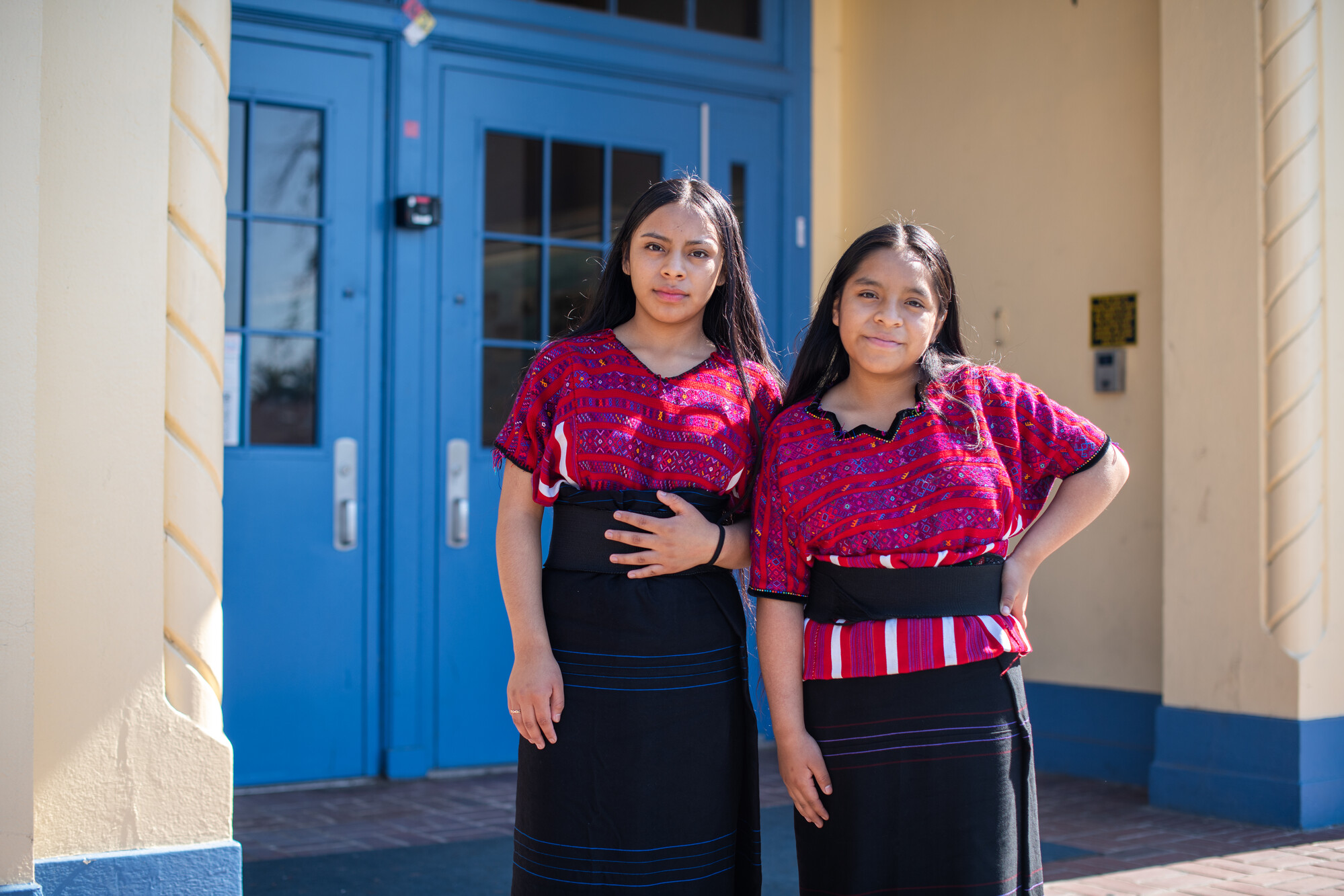 www.eltimpano.org
www.eltimpano.org
>For two years, Latino health advocates have pushed for legislation that would require the state to collect better health data on the number of Mesoamerican indigenous peoples who immigrate to California. After a blow to their efforts in 2023, the proponents of SB1016, also known as the Latino and Indigenous Disparities Reduction Act, are now celebrating—Governor Gavin Newsom signed the bill into law on September 28. >The Latino and Indigenous Disparities Reduction Act passed both chambers of the California State Legislature with overwhelming support in August. Now, with Gov. Newsom’s sign-off, the California Department of Public Health will begin distinguishing Mesoamerican indigenous groups in health data about Latinos. Indigenous peoples from Latin America are typically lumped into government data about Latinos, although many do not identify as Latinos themselves. The World Bank estimates there are 780 indigenous peoples and 560 indigenous languages spoken in Latin America. >The California Department of Public Health will include 10 nationalities and six languages in data collection and will leave a blank space in surveys for people to fill out additional demographic information. The agency will have five years to produce a report that includes rates for major diseases, leading causes of death, and information about pregnancy, housing, and mental health. Then, the department will begin issuing annual reports. [Full article](https://www.eltimpano.org/health/california-enacts-landmark-law-to-improve-health-data-collection-on-indigenous-people-with-roots-in-latin-america/)

The Operation Al-Aqsa Flood, were a series of coordinated attacks carried out by the Islamic Resistance Movement (Hamas) from the Gaza Strip in areas bordering Israel on October 7, 2023. The attacks marked the beginning of the war between Israel and the Gaza Strip that continues to this day. Operation al-Aqsa Flood was a significant turning point in the Palestinian struggle, marking the most fundamental change in the philosophy of resistance since the First Intifada (1987). The Palestinians, who for many decades thought that they would end the occupation and establish an independent state thanks to the support of the Arab world, realized by the mid-1970s that the Arabs would not take the necessary steps in this regard. The leadership of the Palestinian resistance realized that the only path to progress depended on their own will and initiative, and launched a massive uprising against Israel with the power of its people. The First Intifada, therefore, led to a significant paradigm shift in the Palestinian resistance. Rather than waiting for a move from the international community or the Arab world, the local struggle against the occupying Zionist regime, albeit with limited means, could enable Palestine to make gains toward independence. This new strategy also allowed the Palestinian resistance to institutionalize and build a strong identity. Moreover, the establishment of the Islamic Resistance Movement (Hamas) at the beginning of the First Intifada signaled that not only a methodological but also an ideological transformation would take place in the Palestinian resistance. As a matter of fact, in the following years, Hamas’ conception of the political order, the methods it used, the discourse it produced, and its clear stance against the Israeli occupation resulted in this movement finding a response throughout Palestine and becoming one of the most powerful actors in Palestinian political life Hamas’ determined strategy over the years and the combat experience of the Izz ad-Din al-Qassam Brigades allowed for the launch of an operation against Israel from Gaza. The operation, which began on the morning of October 7, marked a paradigm shift in the aftermath of the First Intifada. The Gazan resistance elements, led by the Qassam Brigades, shifted from a defensive model of resistance against Israeli attacks to an offensive strategy of multi-pronged infiltration. In addition, establishing a “joint operation center” of 12 different resistance groups to fight against the occupation forces in a coordinated manner was also noteworthy in uniting all Palestinian groups against the common enemy As the first hours of Operation al-Aqsa Flood sent shockwaves through the Israeli side, the first signs of psychological damage also surfaced. For years, the Israeli state has created a convincing myth about the effectiveness and competence of its intelligence units. The undermining of the general belief that any action posing a threat to Israel inside or outside Palestine would be detected in advance and necessary measures would be taken constituted the first leg of psychological damage that started on October 7. In addition to the failure of the potent intelligence myth after the operation, another myth that collapsed was related to the Iron Dome air defense system. The Iron Dome, widely regarded as one of the most potent air defense systems in the world, failed to fully defend Israel from thousands of Izz ad-Din al-Qassam Brigades missiles. This meant that even points far from Gaza could now threatened by the resistance. The failure of the system it had built has caused more damage than ever to Israel’s state machinery and society. In addition, the neutralization of a large number of army officers and the capture of hundreds of prisoners in the first hours of the operation shows how Operation al-Aqsa Flood dismantled the Israeli security apparatus. The operation Al-Aqsa Flood and its subsequent local, regional and global repercussions, restored the Palestinian cause to its pivotal position on the Arab, regional and international levels, placing it in a central position amongst the general public as a liberation struggle against colonialism and uprooting racism. This provides an exceptional historical opportunity to reestablish the Palestinian cause on the international level as liberation struggle, facing the most unjust racist colonial aims in modern and contemporary history. This significant issue places a heavy load on not only the liberation activists, but also all the vigorous social actors around the world, especially in the Arab region, who bear the responsibility to take action. Those people are obliged to pursue all possible means to support the Palestinian cause and keep pace with the global solidarity with this cause at various political, diplomatic, legal, media, cultural and intellectual levels. - [Operation al-Aqsa Flood: A Rupture in the History of the Palestinian Resistance and Its Implications ](https://www.insightturkey.com/commentaries/operation-al-aqsa-flood-a-rupture-in-the-history-of-the-palestinian-resistance-and-its-implications) - [ Operation Al-Aqsa Flood and the Aftermath: Towards a Global Action for Liberation of Palestine](https://caus.org.lb/en/global-action-for-liberation-of-palestine/) - [Oct 7th and the 'Mass Hannibal Directive'](https://hexbear.net/post/1609134) - [The Gaza Ghetto Uprising](https://brooklynrail.org/2024/05/field-notes/The-Gaza-Ghetto-Uprising/) **Megathreads and spaces to hang out:** - 📀 Come listen to music and Watch movies with your fellow [Hexbears nerd, in Cy.tube](https://live.hexbear.net/c/movies) - 🔥 Read and talk about a current topics in the [News Megathread](https://hexbear.net/post/3627378) - ⚔ Come talk in the [New Weekly PoC thread](https://hexbear.net/post/3627170) - ✨ Talk with fellow Trans comrades in the [New Weekly Trans thread](https://hexbear.net/post/3626970) - 👊 Share your gains and goals with your comrades in the [New Weekly Improvement thread](https://hexbear.net/post/3621440) **reminders:** - 💚 You nerds can join specific comms to see posts about all sorts of topics - 💙 Hexbear’s algorithm prioritizes comments over upbears - 💜 Sorting by new you nerd - 🌈 If you ever want to make your own megathread, you can reserve a spot [here nerd](https://hexbear.net/post/261657) - 🐶 Join the unofficial Hexbear-adjacent Mastodon [instance toots.matapacos.dog](https://toots.matapacos.dog/explore) **Links To Resources (Aid and Theory):** **Aid:** - 🌈 [LGBTQ+ Resource Post](https://hexbear.net/post/279079) - 🍉 [Resources for Palestine](https://buildpalestine.com/2021/05/15/trusted-organizations-to-donate-to-palestine/) - [🐌☕ Zapatista Coffee](https://schoolsforchiapas.org/store/coffee-corn-and-agricultural/zapatista-coffee/) **Theory:** - ❤️[Foundations of Leninism](https://www.marxists.org/reference/archive/stalin/works/1924/foundations-leninism/index.htm) - ❤️[Anarchism and Other Essays](https://theanarchistlibrary.org/library/emma-goldman-anarchism-and-other-essays)
 www.theguardian.com
www.theguardian.com
>A mine excavating coal beneath greater Sydney’s water catchment has damaged a site of “significant” cultural heritage, prompting an investigation by the New South Wales government and warnings from Indigenous elders about “a second Juukan Gorge”. >A routine inspection at the Dendrobium coalmine near Cordeaux dam in March found fracturing and associated rock falls beneath an overhang that features culturally significant artwork, authorities say. Subsidence, as soil and rocks sank into the void left by the mining, is blamed for the cracking. >Four months later, on 25 July, the then mine owner South 32 invited WaterNSW and the registered Aboriginal parties to inspect the damage to the site. The First Nations’ stakeholders were distressed by what they saw, authorities said. >Paul Knight, a former head of the Illawarra Local Aboriginal Land Council, one of the mine’s registered Aboriginal parties, said the damage from coalmining was just the latest involving cultural and environmental sites on the Woronora plateau region north-west of Wollongong. >Knight, who is a traditional custodian of the area, noted that Dendrobium and other mines within the Illawarra Metallurgical Coal group were approved with a “performance measure” based on modelling that less than 10% of such sites would be affected by subsidence. >“The whole system is flawed in terms of accountability,” he said, adding it was up to the mine owner to report damage. Its inspection teams may not visit each year and traditional owners had only limited visiting rights. >Knight said destruction or damage to one site potentially disturbed links to the landscape as a whole. >“Songlines are basically a journey, a path of a story,” he said. “Now if you damage one in the middle, that’s like removing a whole section of pathway [and] you can never journey take that journey again because you’ve disconnected.” >Sydney is among the few cities anywhere in the world to allow mining within its water catchment areas. Scientists have argued for years that the longwalls were causing cracks to reach the surface, diverting water away from some of the 1,000 upland swamps in the Woronora plateau and reducing inflows into nearby dams. [Full article](https://www.theguardian.com/australia-news/2024/oct/07/wheres-the-accountability-indigenous-elders-decry-irreparable-coalmine-damage-to-heritage-site)
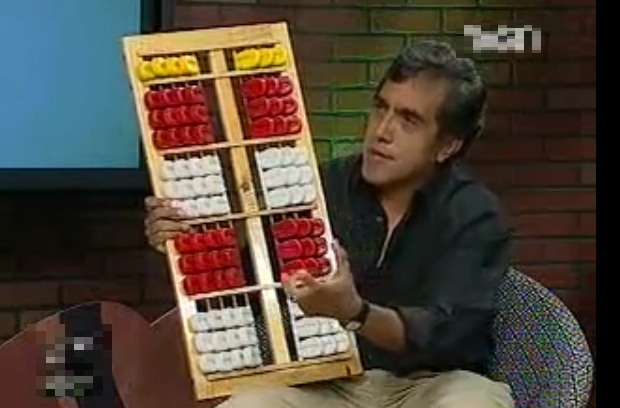 globalvoices.org
globalvoices.org
The nepohualtzintzin is a calculation device used in pre-Hispanic Mesoamerican cultures, including the Mayans, that is now making a comeback in several education programs, which are making use of this powerful tool to teach mathematics at an early age in a completely organic way.
 www.aljazeera.com
www.aljazeera.com
>Maskwacis, Alberta, Canada - Nadalie Lightning stares out of her living room window praying to wake up from what she describes as a nightmare. In the early hours of August 30, her 15-year-old grandson Hoss Lightning Saddleback was shot and killed by Royal Canadian Mounted Police (RCMP) officers after what the RCMP describe as a “confrontation” in the nearby city of Wetaskiwin. >Nadalie is devastated by the loss and struggling to understand how a call for help turned fatal. On the night of his death, Hoss had initially reached out to his grandmother in desperation. >"He was calling me that night. I missed 18 calls," Nadalie revealed, her voice breaking with emotion as the screen on her phone showed her grandson’s attempts to contact her. "He texted me right here at 1:01am, 'Can you come pick me up?' And then it's just, 'I called the police.'" >She had been the one who had always told her grandson to call the police if he was ever in trouble. According to an RCMP release, it was Hoss who had called them, believing people were following him and trying to kill him. >That afternoon members of the Alberta Serious Incident Response Team (ASIRT) showed up at her doorstep asking Nadalie to identify her grandson, one of a string of Indigenous people to have died during interactions with police in Canada since late August. >Speaking to Al Jazeera, the former National Chief of the Assembly of First Nations RoseAnne Archibald, expressed her frustration at what she emphasised was a longrunning issue. >"[The First Nations have] been sounding the alarm bell for a long time - for many, many years,” Archibald said. “This has happened time and time again. They’re just trying to kill us off, it’s maddening. Is that the first way they deal with us, is violence towards us?” [Full article](https://www.aljazeera.com/features/longform/2024/10/3/trying-to-kill-us-off-canadas-indigenous-deaths-at-the-hands-of-police)
 web.archive.org
web.archive.org
>One of the things Ka-Voka Jackson, the Cultural Resources director of the Hualapai Nation, most appreciates about Ha’Kamwe’ is its peacefulness. Located on a former ranch in western Arizona, the hot spring is framed by rolling desert hills. Though trucks may sometimes drive down a nearby dirt road, it’s mostly quiet. That serenity is an important part of Hualapai cultural practices that have taken place here for millennia, from gathering plants to holding ceremonies. >“When we visit and we look across the landscape, that’s the same landscape that our ancestors looked at and that our ancestors lived in, and so we hold a deep connection with the integrity of that landscape,” Jackson said. >But amid the green energy boom, Ha’Kamwe’ is threatened by lithium exploration by the Australia-based company Arizona Lithium (AZL), and these days, peace seems elusive. Already, the mining company has drilled approximately 50 exploratory wells near the hot springs, disturbing the tribe’s cultural practices and threatening the aquifer. Since 2021, when High Country News first covered the threat that this drilling poses to Hualapai religious practices, the Bureau of Land Management has signed off on even more drilling near Ha’Kamwe’. This July, the BLM approved AZL’s plan to bore approximately 130 more wells near the hot spring, reaching more than 300 feet deep and surrounding the hot spring on three sides. AZL will construct drill pads sites, roads and other support infrastructure as it surveys the area further for a potential open-pit lithium mine. >On Aug. 8, the Hualapai Nation sued the BLM and the Department of the Interior. According to the lawsuit, the agencies violated multiple laws, including the National Environmental Policy Act and the National Historic Preservation Act, in approving this new phase of exploratory mining. Since September, AZL has been under a temporary restraining order to prevent further drilling. [full article](https://web.archive.org/web/20241003015736/https://www.hcn.org/articles/will-exploratory-lithium-mining-continue-near-a-sacred-hot-spring/)
 newlinesmag.com
newlinesmag.com
>The Kurdistan Workers’ Party (PKK) is arguably one of the most important non-state actors in modern West Asia. While fighting a brutal guerrilla war against the Turkish government, it has also managed to inspire Kurdish movements in Syria, Iraq and Iran, as well as Iran’s non-Kurdish protesters. In a region where many parties are nakedly sectarian, the PKK has gone from Marxist-Leninist nationalism to a form of radical-democratic “libertarian municipalism” inspired by the late anarchist thinker Murray Bookchin. >For better or worse, the PKK exists today only because the Democratic Front for the Liberation of Palestine (DFLP), a now-obscure Palestinian force, agreed to shelter some Kurdish exiles in the 1980s. That experience in the Palestinian camps permanently affected the worldview of the PKK’s founding generation. Not only did the PKK learn how to fight a guerrilla war, it also walked away with a strong sense of internationalism. >In fact, some of the PKK’s founding figures spent time in an Israeli detention camp as prisoners of war. Old issues of the party magazine Serxwebun tell the remarkable story of the “Beaufort Castle Heroes,” a group of Kurds who had been training at a Palestinian base in Lebanon when they were captured by Israeli forces in June 1982. (Serxwebun means “independence” in Kurdish.) New Lines is reporting much of their story in English for the first time. >The June 1984 edition of Serxwebun features drawings and poetry from the prisoners, including one Iranian Kurdish fighter. The Iranian Kurd, codenamed Sami, recalled being beaten by an Israeli interrogator who shouted, “You came to kill Jews, you’re lying … Kurdistan, Turkistan, Bangladesh, Iran, Arab, you are all antisemitic, we will kill you all.” >The PKK was just one of many foreign fighter contingents in Lebanon. (Sami was captured alongside a Bangladeshi fighter, and another Serxwebun article mentioned the presence of an Iranian from the left-wing People’s Fedai Guerrillas.) At the time, the Palestinian movement was the international leftist cause celebre, and leftists understood it to be part of an unbroken chain of Third World liberation struggles. >“If you know Vietnam, you know Kurdistan … a new Vietnam in our hearts,” Sami wrote in a poem. “To the defenseless prisoner in Diyarbakir, to the leaf on the tree in Vietnam, to the living being in Hiroshima and Nagasaki, to the orphan baby in Sabra and Shatila.” [Full Article](https://newlinesmag.com/argument/the-kurds-who-died-for-palestine/) Extra reading: [PKK Internationalists in the Palestinian Resistance ](https://internationalistcommune.com/pkk-internationalists-in-the-palestinian-resistance/) 
 news.mongabay.com
news.mongabay.com
- The Indonesian government is embarking on yet another project to establish a massive area of farmland at the expense of forests and Indigenous lands, despite a long history of near-identical failures. - The latest megaproject calls for clearing 1 million hectares (2.5 million acres) in the district of Merauke in the eastern region of Papua for rice fields. - Local Indigenous communities say they weren’t consulted about the project, and say the heavy military presence on the ground appears to be aimed at silencing their protests. - Similar megaprojects, on Borneo and more recently also in Merauke, all failed, leaving behind destroyed landscapes, with the current project also looking “assured to fail,” according to an agricultural researcher. >JAKARTA — Indigenous Papuans say they’ve been caught off guard by helicopters flying over their villages and excavators tearing down their forests in their area, all while accompanied by the Indonesian military. >What they’re being subjected to is one of the largest deforestation projects in the world, which will see the development of 1 million hectares (2.5 million acres) of rice fields in Merauke, a district in Indonesia’s Papua region that borders Papua New Guinea. >The military is involved in the project because it’s led by the Ministry of Defense and has been designated a project of national strategic importance. Defense Minister Prabowo Subianto, who will be sworn in as Indonesia’s next president on Oct. 20, has appointed the hugely controversial Jhonlin Group to help administer the project. >The military’s involvement, coupled with the lack of free, prior, informed consent (FPIC) from Indigenous communities living in the area, have fueled concerns that the project will create new conflicts in the region. >Indonesia has maintained a heavy military presence in the Papua region since annexing it in 1963, with security forces frequently accused of committing human rights violations under the justification of cracking down on a low-level independence movement. [Full article](https://news.mongabay.com/2024/10/past-failures-cant-stop-indonesia-from-clearing-forests-indigenous-lands-for-farms/)
>ONONDAGA NATION TERRITORY (AP) — The Onondaga Nation has regained 1,000 acres (405 hectares) of its ancestral land in upstate New York, a tiny portion of the land members say was unjustly taken by the state beginning in the 18th century. >The heavily forested land is south of Syracuse and near the Onondaga’s federally recognized territory. The land, which includes headwaters of Onondaga Creek, was transferred by Honeywell International on Friday under a federal Superfund settlement related to the contamination of the environment, according to the Onondaga Nation. >The land is part of an expanse of 2.5 million acres (1 million hectares) in central New York the Onondagas say was taken over decades by New York beginning in 1788 through deceitful maneuvers that violated treaties and federal law. >Sid Hill, the Tadodaho, or chief, of the Onondaga Nation, said Monday they were grateful to federal and state officials for working with them to return “the first 1,000 acres of the 2.5 million acres of treaty-guaranteed land taken from us over the centuries.” >“This is a small but important step for us, and for the Indigenous land back movement across the United States,” Hill said in a prepared statement.
 thewalrus.ca
thewalrus.ca
>“Tansi, today we are going through some random phrases,” Julia Ouellette says to the camera. She holds up slips of paper with English words while repeating the Cree translations quickly and then slowly. “tantahtwaw,” she says, holding a paper that says “how many,” emphasizing each syllable. “tantahtwaw. Repeat after me.” >Ouellette, a grandmother from Makwa Sahgaiehcan First Nation in Saskatchewan, posts Cree-language videos regularly on TikTok, where she has more than 16,800 followers. The videos are casual, with a simple formula: Ouellette, in glasses, with her hair tied back, offers viewers a few Cree words or phrases to practise aloud. In both languages, her voice has the distinct quality of a Cree speaker: rich and resonant, her “r”s and “l”s—consonants not found in Cree—are especially pronounced when she speaks English. A former language teacher at Big Island Lake Cree Nation in Saskatchewan, she started posting videos on TikTok in 2020 that included such COVID-era phrases as “wash your hands” (kasichiche) and “get away” (awas), along with more cheerful ones, like “Merry Christmas” (miyo-manitowi-kîsikanisi). Ouellette never writes out the Cree words or phrases, instead instructing the viewer to repeat what they hear. >Ouellette is part of a growing community of Indigenous-language speakers using social media as a teaching tool. James Vukelich Kaagegaabaw, a descendant of Turtle Mountain, shares an Ojibwe word regularly with his 135,000 Instagram followers. Jonathan Augustine, who goes by RezNeck Farmer on TikTok, shares Mi’kmaw lessons along with folksy videos about gardening. Zorga Qaunaq, under the username Tatiggat, posts on TikTok about daily life, beading, and Inuit culture, alongside how to properly pronounce words like “Inuit.” [Full article](https://thewalrus.ca/indigenous-languages/)

At the beginning of the 1830s, nearly 125,000 Native Americans lived on millions of acres of land in Georgia, Tennessee, Alabama, North Carolina and Florida–land their ancestors had occupied and cultivated for generations. By the end of the decade, very few natives remained anywhere in the southeastern United States. Working on behalf of white settlers who wanted to grow cotton on the Indians’ land, the federal government forced them to leave their homelands and walk hundreds of miles to a specially designated “Indian territory” across the Mississippi River. Taking the journey through an unusually cold winter, they suffered terribly from exposure, disease, and starvation, killing several thousand people while en route to their new designated reserve. They were also attacked by locals and economically exploited - starving Indians were charged a dollar a head (equal to $24.01 today) to cross the Ohio River, which typically charged twelve cents, equal to $2.88 today. Indian Removal Andrew Jackson had long been an advocate of what he called “Indian removal.” As an Army general, he had spent years leading brutal campaigns against the Creeks in Georgia and Alabama and the Seminoles in Florida–campaigns that resulted in the transfer of hundreds of thousands of acres of land from Indian nations to white farmers. As president, he continued this genocide. In 1830, he signed the Indian Removal Act, which gave the federal government the power to exchange Native-held land in the cotton kingdom east of the Mississippi for land to the west, in the “Indian colonization zone” that the United States had acquired as part of the Louisiana Purchase. (This “Indian territory” was located in present-day Oklahoma.) The law required the government to negotiate removal treaties fairly, voluntarily and peacefully: It did not permit the president or anyone else to coerce Native nations into giving up their land. However, President Jackson and his government frequently ignored the letter of the law and forced Native Americans to vacate lands they had lived on for generations. In the winter of 1831, under threat of invasion by the U.S. Army, the Choctaw became the first nation to be expelled from its land altogether. They made the journey to Indian Territory on foot (some “bound in chains and marched double file,” one historian writes) and without any food, supplies or other help from the government. Thousands of people died along the way. It was, one Choctaw leader told an Alabama newspaper, a “trail of tears and death.” The Trail of Tears The Indian-removal process continued. In 1836, the federal government drove the Creeks from their land for the last time: 3,500 of the 15,000 Creeks who set out for Oklahoma did not survive the trip. The Cherokee people were divided: What was the best way to handle the government’s determination to get its hands on their territory? Some wanted to stay and fight. Others thought it was more pragmatic to agree to leave in exchange for money and other concessions. In 1835, a few self-appointed representatives of the Cherokee nation negotiated the Treaty of New Echota, which traded all Cherokee land east of the Mississippi for $5 million, relocation assistance and compensation for lost property. To the federal government, the treaty was a done deal, but many of the Cherokee felt betrayed; after all, the negotiators did not represent the tribal government or anyone else. “The instrument in question is not the act of our nation,” wrote the nation’s principal chief, John Ross, in a letter to the U.S. Senate protesting the treaty. “We are not parties to its covenants; it has not received the sanction of our people.” Nearly 16,000 Cherokees signed Ross’s petition, but Congress approved the treaty anyway. By 1838, only about 2,000 Cherokees had left their Georgia homeland for Indian Territory. President Martin Van Buren sent General Winfield Scott and 7,000 soldiers to expedite the removal process. Scott and his troops forced the Cherokee into stockades at bayonet point while his men looted their homes and belongings. Then, they marched the Indians more than 1,200 miles to Indian Territory. Whooping cough, typhus, dysentery, cholera and starvation were epidemic along the way, and historians estimate that more than 5,000 Cherokee died as a result of the journey. By 1840, tens of thousands of Native Americans had been driven off of their land in the southeastern states and forced to move across the Mississippi to Indian Territory. The federal government promised that their new land would remain unmolested forever, but as the line of white settlement pushed westward, “Indian Country” shrank and shrank. In 1907, Oklahoma became a state and Indian Territory was gone for good. - [Trail of Tears cherokeehistorical](https://cherokeehistorical.org/trail-of-tears/) - [Trail of Tears Britannica](https://www.britannica.com/event/Trail-of-Tears) **Megathreads and spaces to hang out:** - 📀 Come listen to music and Watch movies with your fellow [Hexbears nerd, in Cy.tube](https://live.hexbear.net/c/movies) - 🔥 Read and talk about a current topics in the [News Megathread](https://hexbear.net/post/3311273) - ⚔ Come talk in the [New Weekly PoC thread](https://hexbear.net/post/3468550) - ✨ Talk with fellow Trans comrades in the [New Weekly Trans thread](https://hexbear.net/post/3363552) - 👊 Share your gains and goals with your comrades in the [New Weekly Improvement thread](https://hexbear.net/post/3518054) **reminders:** - 💚 You nerds can join specific comms to see posts about all sorts of topics - 💙 Hexbear’s algorithm prioritizes comments over upbears - 💜 Sorting by new you nerd - 🌈 If you ever want to make your own megathread, you can reserve a spot [here nerd](https://hexbear.net/post/261657) - 🐶 Join the unofficial Hexbear-adjacent Mastodon [instance toots.matapacos.dog](https://toots.matapacos.dog/explore) **Links To Resources (Aid and Theory):** **Aid:** - 🌈 [LGBTQ+ Resource Post](https://hexbear.net/post/279079) - 🍉 [Resources for Palestine](https://buildpalestine.com/2021/05/15/trusted-organizations-to-donate-to-palestine/) - [🐌☕ Zapatista Coffee](https://schoolsforchiapas.org/store/coffee-corn-and-agricultural/zapatista-coffee/) **Theory:** - ❤️[Foundations of Leninism](https://www.marxists.org/reference/archive/stalin/works/1924/foundations-leninism/index.htm) - ❤️[Anarchism and Other Essays](https://theanarchistlibrary.org/library/emma-goldman-anarchism-and-other-essays)
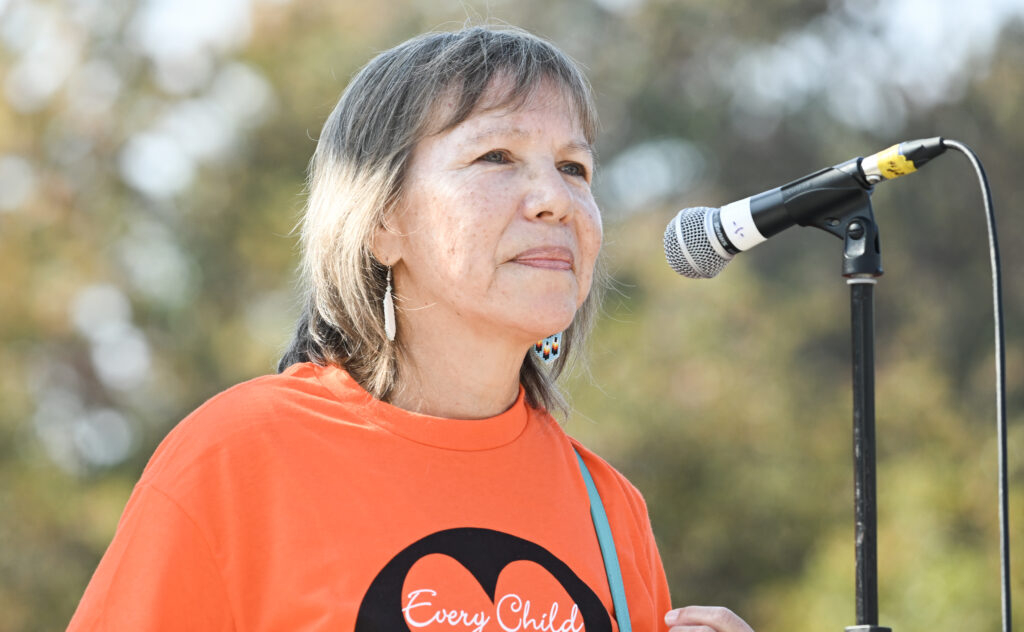 thenarwhal.ca
thenarwhal.ca
>'Colonial-rooted poverty will not be solved by more colonial solutions' >Thirty-four years ago, Katsi’tsakwas Ellen Gabriel was thrust into the spotlight when she was chosen as the spokesperson for the Kanienʼkehá:ka (Mohawk) communities of Kanehsatà:ke and Kahnawà:ke, as they resisted the planned expansion of a golf course on into their sacred lands and burial grounds in southern Quebec and police and military attempted to subdue them by force. >“You do not call it the Oka Crisis,” Gabriel tells me, of the village near the golf course that media and Canadians generally use to refer to the confrontation. “Oka caused the crisis. It was Kanehsatà:ke and Kahnawà:ke that were under siege, and were attacked because of the municipality of Oka and the private corporations behind the project.” >In the decades since the 78-day standoff ended, Gabriel has remained a steadfast defender of Indigenous homelands and an advocate for Indigenous Rights and sovereignty, particularly the rights of women. She has spoken at the United Nations and addressed Parliament, and served for more than six years as president of the Quebec Native Women’s Association, drawing connections between the protection of Indigenous lands and the rights, dignity and future of Indigenous nations. >In a new book, When the Pine Needles Fall, Gabriel and settler historian Sean Carleton chart a course from the events of 1990 to the present, while extending into a generous and expansive vision of the future. The book, which they began writing in 2019, evolved during the pandemic, taking shape as a series of conversations that articulate the urgency and necessity of Indigenous resistance. Centring Gabriel’s own words through dialogue, Carleton writes, was a way to “divest my power and authority as an academic to create space for Ellen’s brilliance … to hold space and amplify Ellen’s voice, while also co-creating through conversation.” [Full article  ](https://thenarwhal.ca/ellen-gabriel-indigenous-resistance/)
 time.com
time.com
>In the Navajo Nation—a sweeping landscape of red-rock canyons and desert that takes in the Four Corners—water is not taken for granted. Here, more than 1 in 3 Diné, as Navajo people call themselves, must haul water to their homes, often across long distances. The Diné use the least amount of water per person of anyone in the U.S., and pay the most. >The problem, as old as the land itself, was predicted. The hydrology of the Colorado River Basin is highly variable, a fact that was not fully appreciated (or was flatly ignored) by those who drafted the foundational policy that governs water use in much of the West—the 1922 Colorado River Compact. Despite warnings from experts, the compact based the amount of water to be divided among its signatories on a brief period that proved to be one of the wettest in history. This flaw was compounded by tremendous population growth, Indigenous dispossession, competing values, procrastination, and deadlocked disputes over how water is used. >On paper, the Navajo Nation is drenched in water. Under the “first in line, first in right” principle that defines water use in the West, the Diné have first dibs on the same declining supply that serves Washington County, which has roughly as many people on one-tenth the land: the Colorado River, its tributaries, and two underlying aquifers. Yet little of it reaches them. In 2023, the U.S. Supreme Court ruled, in Arizona v. Navajo Nation, that the federal government has no obligation to provide water to the Navajo Nation. But by the time of the ruling, a crucial exercise of “first rights” was already in peril. >The Navajo-Gallup Water Supply Project aims to deliver treated water from the San Juan River to 240,000 people via 300 miles of pipes. Conceived in the 1960s and begun in 2009, the $2.1 billion project must be completed by Dec. 31 or the Navajo Nation loses its right to that water. It's far from done. Its fate resides in U.S. House Bill 3977, which would extend the deadline to 2029 and appropriate $689.45 million to finish the job. >Washington County isn’t the cause of the Navajo -Nation’s thirst. The water gap is an enduring legacy of manifest destiny; the infrastructure, and legislation, that came with it still largely define how water is used. In the American West, irrigated agriculture uses a whopping 86% of fresh water consumed—the largest share by far going to animal-forage crops like alfalfa. Privately, a St. George resident told me, “Why should I compromise the things that bring me enjoyment when alfalfa is still being grown? I hate to say that out loud, but that’s the reality.” On the other hand, since 2002, water--strapped Southern Nevada, including Las Vegas, cut its use by 26% while adding 750,000 people—proof that measures like the Post-2026 Operational Guidelines really matter. [Full Article ](https://time.com/7019660/colorado-river-water-drought-navajo-nation/) 
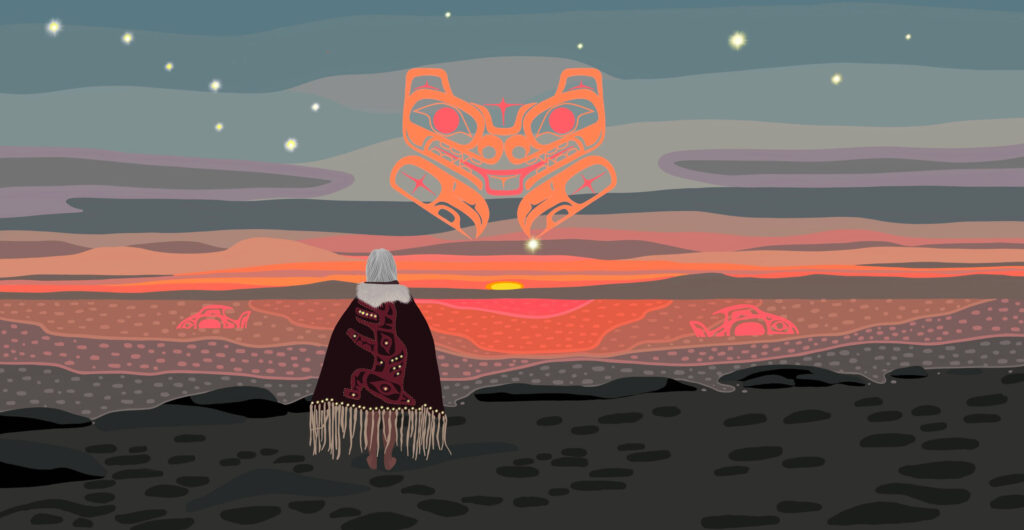 thenarwhal.ca
thenarwhal.ca
>In 1876, Canada adopted the Indian Act. The legislation established which Indigenous people were legally recognized through the Indian status system and implemented colonial structures like the reserve system, which restricted First Nations people to lands “reserved” for them to live on, a fraction of their ancestral territories. >The Indian Act still dictates much of Indigenous people’s lives, including many land rights. Only a status “Indian” has the constitutionally protected right to hunt, fish, harvest and live on reserve lands, the last of which is no longer mandatory. >The more status “Indians” there are, in other words, the more people for whom Canada is legally obligated to uphold treaty promises, including to share lands and resources. Which is why, from the beginning, “Canada was very clear that the goal of the [Indian Act] was ultimately to assimilate all First Nations individuals,” Vancouver lawyer Ryan Beaton says. >To expedite assimilation, Indigenous people were pushed to accept enfranchisement, which meant renouncing Indian status in order to gain Canadian citizenship. Although enfranchisement was framed as voluntary, coercive policies outlined in the Indian Act would suggest otherwise. Status holders couldn’t own property off reserve, buy alcohol or vote. Indigenous men were automatically enfranchised if they got a university degree or became priests. >Indigenous women had even less choice regarding assimilation, because of gender discrimination in the Indian Act. If an Indigenous woman married a non-status or a non-Indigenous man, she lost her own status and was no longer recognized as a member of her First Nation. If she married an Indigenous man with status in a nation other than her own, she lost her own status number and band membership, becoming legally recognized through her husband’s First Nation and seen as an entity attached to his status number. And if an Indigenous man was enfranchised, his wife and children lost their status too. [Full article](https://thenarwhal.ca/canada-bill-c38-indigenous-land-rights/)
 www.theguardian.com
www.theguardian.com
>As the helicopter approached Caas Tl’aat Kwah (also known as Serb Creek), a 1,600-hectare (about 3,953-acre) watershed, the forest became a blanket of deep green, cleaved only by yellow-green wetlands threaded with glacial blue streams. >“We want to conserve it for future generations,” said Charlotte Euverman, the Wet’suwet’en woman leading a fight to save this area, which includes a traditional feasting site. “We have to leave them something.” >Like most First Nations here, Wet’suwet’en never signed treaties with the Canadian or provincial governments. Nevertheless, the latter took the land and leased forested acreage to logging companies. Today just 20% of British Columbia’s old-growth forests remain. >In 2020, after decades of activist pressure, the province identified about a quarter of the remaining old growth as at high risk for logging and recommended a pause while deciding their fate. Yet today, logging has been deferred in less than half of the high-risk area >Now Caas Tl’aat Kwah is in the crosshairs of a debate over the scope of First Nations’ agency, biodiversity loss and protection – and the role industrial logging plays in amplifying Canada’s forest fires, the effects of which are being felt across the globe. >In summer 2023, more than 150,000 sq km (58,000 sq miles) burned across the country, an all-time record, carrying smoke across the continent and air pollution all the way to Europe and China. >Caas Tl’aat Kwah is not yet accessible by road, so the helicopter ride was the first opportunity for Nation member Sandra Harris to see it, despite the fact that her great-grandfather, Jack Joseph, once had a cabin there. The pilot set the helicopter down upon a boggy meadow, and DeWit, who is acting director of the Office of Wet’suwet’en, led the way through the trees to a newer cabin, where he gave a framed photo of Joseph pride of place. >Harris explained the significance of seeing the land, saying: “We have a lot of stress in our lives with racism, working with colonial systems that are so unkind to our ways.” The land is healing, she said. >“Today, we can feel our ancestors,” Harris said. “We remember our stories when we are able to put our feet on the land … There’s lots of good medicine there for us.” >Conventional wisdom has long held that increased fire severity is due not just to climate change but also dense overgrowth from fire suppression. The prescription has been to thin forests and set controlled burns. But a growing number of scientists now say that approach fails to recognize the role of industrial logging in increased fire severity: it kills complex communities of life that stabilize the water cycle. [Full Article](https://www.theguardian.com/world/2024/sep/23/canada-first-nation-forest-wildfire-logging) 
 edition.cnn.com
edition.cnn.com
>The highest peak at Great Smoky Mountains National Park is officially reverting to its Cherokee name more than 150 years after a surveyor named it for a Confederate general. >The US Board of Geographic Names voted on Wednesday in favor of a request from the Eastern Band of Cherokee Indians to officially change the name Clingmans Dome to Kuwohi, according to a news release from the park. The Cherokee name for the mountain translates to “mulberry place.” >“The Great Smoky National Park team was proud to support this effort to officially restore the mountain and to recognize its importance to the Cherokee People,” Superintendent Cassius Cash said in the release. >“The Cherokee People have had strong connections to Kuwohi and the surrounding area, long before the land became a national park. The National Park Service looks forward to continuing to work with the Cherokee People to share their story and preserve this landscape together.” >Kuwohi is a sacred place for the Cherokee people and is the highest point within the traditional Cherokee homeland, according to the park. The peak is visible from the Qualla Boundary, home of the Eastern Band of Cherokee Indians. Great Smoky Mountains National Park closes Kuwohi every year for three half-days so that predominantly Cherokee schools can visit the mountain and learn its history. [full article](https://edition.cnn.com/travel/clingmans-dome-tennessee-kuwohi-name-change/index.html) The name was changed from a confederate brigadier general to a native name so its a double win 
>"It was different because there wasn't a lot of education [about] our people," she said. "So I only learned my history through my family members." >Years later, Tenasco is learning much more about her culture and her ancestors at a different kind of school — a federally-funded Indigenous archeological field school called Anishinabe Odjibikan. >The school brings together young members of the Algonquin communities of Kitigan Zibi in Quebec and Pikwakanagan in Ontario to dig up, clean and sort items used by their ancestors thousands of years ago. >Tenasco and her fellow Anishinabe Odjibikan participants learn how to document layers of earth and rocks, identify materials and determine if they're local to the area, use surveyor's tools and clean and reassemble pottery pieces found at a dig site. >Anishinabe Odjibikan is part of a growing trend in archaeology of involving the Indigenous peoples whose lands are being excavated — with the work either being led by Indigenous people, done collaboratively or carried out with their consent. >According to Cree/Métis archaeologist Paulette Steeves, the last century of archaeology has invalidated the pre-contact history of the Americas — and the people who lived there for thousands of years. [Full Article](https://www.cbc.ca/radio/unreserved/indigenous-led-archaeology-1.6854258)
Heard about it from a Lakota artist I follow. Figure this one is worth keeping an eye on.
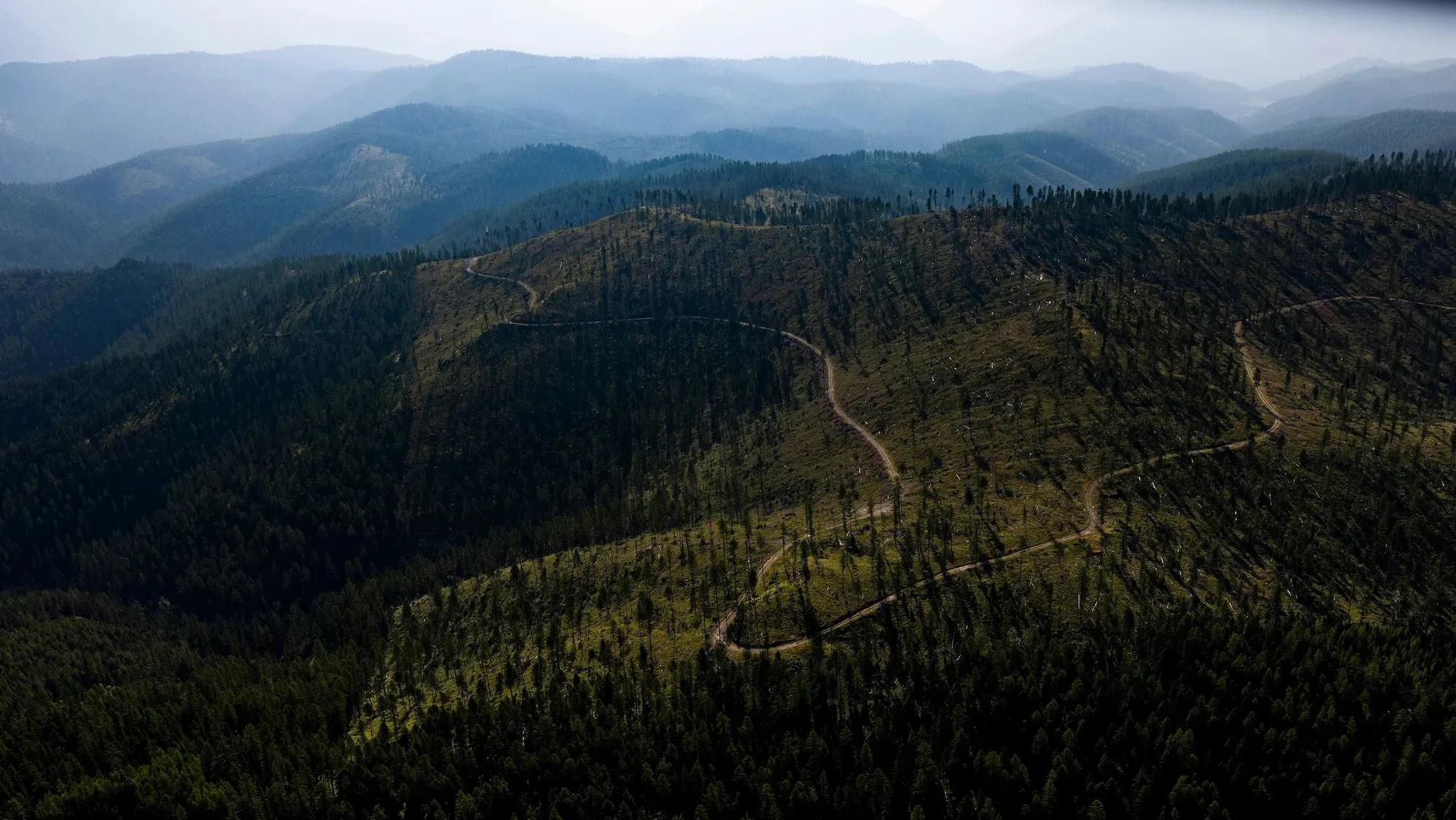 grist.org
grist.org
> “It’s not that they’re mismanaging everything, but their management philosophy and scheme do not align with ours,” said Tony Incashola Jr., the director of tribal resources for the Confederated Salish and Kootenai Tribes, or CSKT, as he looked out the window of his Jeep at the landscape. “Their tactics sometimes don’t align with ours, which in turn affects our capability of managing our land.” >State trust lands, on and off Indian reservations, make up millions of acres across the Western United States and generate revenue for public schools, universities, jails, hospitals, and other public institutions by leasing them for oil and gas extraction, grazing, rights of way, timber, and more. The state of Montana, for example, manages 5.2 million surface acres and 6.2 million subsurface acres, a term pertaining to oil, gas, minerals, and other underground resources, which distributed $62 million to public institutions in 2023. The majority of that money went to K-12 schools — institutions serving primarily non-Indigenous people. >States received many of these trust lands upon achieving statehood, but more were taken from tribal nations during the late 19th and early 20th centuries through a federal policy of allotment, in which reservations were forcibly cut up into small parcels in an effort to make Indigenous peoples farmers and landowners. The policy allowed for about 90 million acres of reservation lands nationwide to move to non-Indigenous ownership. On the Flathead Reservation, allotment dispossessed the CSKT of a million acres, more than 60,000 of which were taken to fund schools. [Full article](https://grist.org/indigenous/how-schools-hospitals-and-prisons-in-15-states-profit-from-land-and-resources-on-79-tribal-nations/)
 news.mongabay.com
news.mongabay.com
- The Brazilian military has been involved in a series of controversial episodes that have undermined emergency efforts to tackle the humanitarian crisis in the Yanomami Indigenous Territory. - Reports show it failed (or sabotaged) airspace control and food deliveries to the Indigenous people, who suffer from malnutrition as a result of mercury contamination from illegal mining. - President Luiz Inácio Lula da Silva has spent millions trying to evict the illegal miners and provide care to the Yanomami, but some 7,000 miners remain in the territory, while malnutrition, malaria and other diseases continue to afflict the Yanomami. - Experts blame the military’s inaction of action against the illegal miners on a colonial ideology that was prevalent under Brazil’s former military dictatorship, and which was revived under the administration of Lula’s predecessor, Jair Bolsonaro. >In 1964, the Brazilian military launched a coup d’état, overthrowing the democratically elected government and seizing control of the country. What followed was a 21-year dictatorship, authoritarian rule, censorship, and repression. The generals who took power were driven by their version of McCarthyism, fighting all aspects of civilian life that they accused of being communist or socialist. >The generals were backed by the elite, which had an interest in exploiting Brazil’s vast natural resources. Central to this vision was the Amazon Rainforest. They viewed it as a largely untamed and unpopulated wilderness. To the military regime, the Amazon was not a rich ecosystem teeming with life, nor was it the ancestral home of numerous Indigenous communities who had cared for it and made it home for millennia. Instead, it was a frontier to be conquered, a resource to be exploited in the name of progress and national security. Doing so also served their fearmongering narrative that a foreign enemy could invade Brazil through the jungle. >That ideology was (and still is) explicitly anti-Indigenous and anti-environmental, seeing the forest and its inhabitants as obstacles to be removed in the name of so-called development. >The dictatorship launched a series of aggressive policies aimed at integrating the Amazon into the economy. Slogans like “Integrar para não entregar” (“Integrate to avoid surrender”) reflected the regime’s belief that failing to develop the Amazon would leave it vulnerable to foreign exploitation. [Full article](https://news.mongabay.com/2024/09/how-the-brazilian-military-sabotaged-protection-of-indigenous-people-in-the-amazon/)
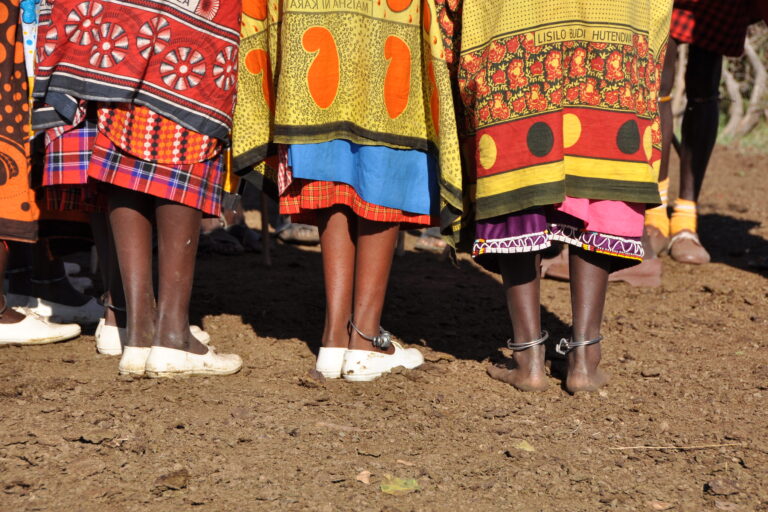 news.mongabay.com
news.mongabay.com
by Bobby Bascomb - In 2022, the government of Tanzania began relocating Indigenous Maasai pastoralists from their ancestral home inside and near Ngorongoro Conservation Area. - Locals say they’ve been forcibly evicted from their land and denied access to grazing areas for livestock and basic social services including health care, education and the right to vote. - Maasai women have been profoundly affected, some turning to prostitution to survive once communities fell apart. >In 2022, the government of Tanzania began forcibly evicting thousands of Indigenous Maasai from 1,500 square kilometers, nearly 600 square miles, of their ancestral land to make way for elite tourism in the renowned Ngorongoro Conservation Area. A large group of Maasai recently blocked the road leading to Ngorongoro, protesting the evictions and denial of government services including health care, education and the right to vote. After the protests, the president of Tanzania ordered social services be restored, though local residents told Mongabay they still haven’t been. >“Hundreds of families were pushed into extreme poverty as the government confiscated and sold their livestock in public markets,” a local aid worker told Mongabay. A local woman told Mongabay that the communal grazing land used by the Maasai was taken by the government, so any cows that remained grew too skinny to produce milk, a staple food for the Indigenous group and a product they sell to buy other foods. >Mongabay spoke with five Maasai women from the area, all of whom requested anonymity for fear of retaliation. Some names have been changed to protect their identities. “The threats are numerous, including daily arrests, especially for those of us who advocate for human rights. This situation seriously threatens our lives,” a local woman told Mongabay in an email. [Full article](https://news.mongabay.com/2024/09/maasai-women-struggle-to-survive-amid-forced-evictions-in-conservation-area/)



